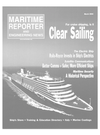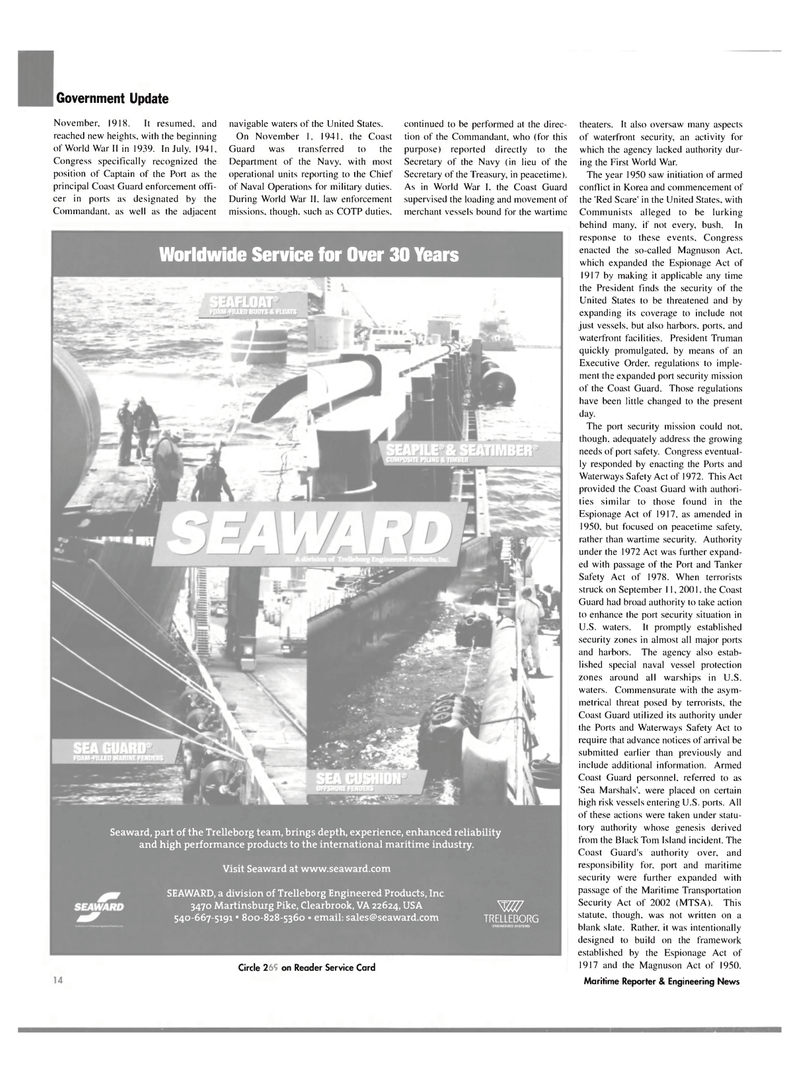
Page 14: of Maritime Reporter Magazine (March 2004)
The Cruise Shipping Edition
Read this page in Pdf, Flash or Html5 edition of March 2004 Maritime Reporter Magazine
Government Update
November, 1918. It resumed, and reached new heights, with the beginning of World War II in 1939. In July, 1941,
Congress specifically recognized the position of Captain of the Port as the principal Coast Guard enforcement offi- cer in ports as designated by the
Commandant, as well as the adjacent navigable waters of the United States.
On November 1. 1941, the Coast
Guard was transferred to the
Department of the Navy, with most operational units reporting to the Chief of Naval Operations for military duties.
During World War II. law enforcement missions, though, such as COTP duties. continued to be performed at the direc- tion of the Commandant, who (for this purpose) reported directly to the
Secretary of the Navy (in lieu of the
Secretary of the Treasury, in peacetime).
As in World War I. the Coast Guard supervised the loading and movement of merchant vessels bound for the wartime
Circle 237 on Reader Service Card theaters. It also oversaw many aspects of waterfront security, an activity for which the agency lacked authority dur- ing the First World War.
The year 1950 saw initiation of armed conflict in Korea and commencement of the 'Red Scare' in the United States, with
Communists alleged to be lurking behind many, if not every, bush. In response to these events. Congress enacted the so-called Magnuson Act, which expanded the Espionage Act of 1917 by making it applicable any time the President finds the security of the
United States to be threatened and by expanding its coverage to include not just vessels, but also harbors, ports, and waterfront facilities. President Truman quickly promulgated, by means of an
Executive Order, regulations to imple- ment the expanded port security mission of the Coast Guard. Those regulations have been little changed to the present day.
The port security mission could not. though, adequately address the growing needs of port safety. Congress eventual- ly responded by enacting the Ports and
Waterways Safety Act of 1972. This Act provided the Coast Guard with authori- ties similar to those found in the
Espionage Act of 1917, as amended in 1950, but focused on peacetime safety, rather than wartime security. Authority under the 1972 Act was further expand- ed with passage of the Port and Tanker
Safety Act of 1978. When terrorists struck on September 11, 2001, the Coast
Guard had broad authority to take action to enhance the port security situation in
U.S. waters. It promptly established security zones in almost all major ports and harbors. The agency also estab- lished special naval vessel protection zones around all warships in U.S. waters. Commensurate with the asym- metrical threat posed by terrorists, the
Coast Guard utilized its authority under the Ports and Waterways Safety Act to require that advance notices of arrival be submitted earlier than previously and include additional information. Armed
Coast Guard personnel, referred to as 'Sea Marshals', were placed on certain high risk vessels entering U.S. ports. All of these actions were taken under statu- tory authority whose genesis derived from the Black Tom Island incident. The
Coast Guard's authority over, and responsibility for, port and maritime security were further expanded with passage of the Maritime Transportation
Security Act of 2002 (MTSA). This statute, though, was not written on a blank slate. Rather, it was intentionally designed to build on the framework established by the Espionage Act of 1917 and the Magnuson Act of 1950. 16 Maritime Reporter & Engineering News
Worldwide Service for Over 30 Years
Seaward, part of the Trelleborg team, brings depth, experience, enhanced reliability and high performance products to the international maritime industry.
Visit Seaward at www.seaward.com
SEAWARD, a division of Trelleborg Engineered Products, Inc. 3470 Martinsburg Pike, Clearbrook, VA 22624, USA 540-667-5191 • 800-828-5360 • email: [email protected] w TRELLEBORG

 13
13

 15
15
